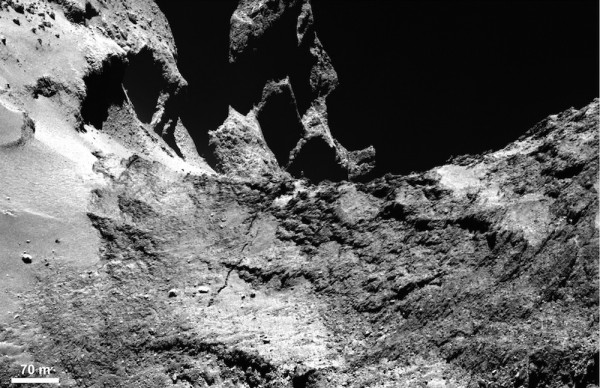
After the excitement of the Rosetta spaceraft’s rendezvous with Comet 67P/Churyumov-Gerasimenko in August, 2014 – then the drama of its little Philae lander’s bounce across the comet’s surface in November – you might think things couldn’t get more interesting for this wonderful European Space Agency (ESA) comet mission. But now they have. In a special edition of the journal Science published on January 23, 2015, scientists have released results from seven of Rosetta’s 11 science instruments. Among the most fascinating of the newly announced results is a prominent and intriguing 500-meter-long crack – as long as five American football fields – between the two lobes of the comet, running roughly parallel to the comet’s neck.
You can see the crack in the images above and below. Some comets split into pieces as they draw near the sun. Will Comet 67P/Churyumov-Gerasimenko break up or split in two as it nears the sun? You wouldn’t think so, since this comet was likely chosen in part for the conservative nature of its orbit. But, if scientists could see changes in the crack, it would be amazing!
It’s not known, of course, if the crack results from recent stresses in this region, occurring as the comet sweeps in toward its closest point to the sun – its perihelion – on August 13, 2015. The comet is known to be subject to a rapid heating-cooling cycle, experienced over its 12.4-hour day and over its 6.5-year elliptical orbit around the sun, and the crack likely results from that heating and cooling.
This comet is not a sun-grazer, however, and will not get extremely close to the sun. In fact, at perihelion, 67P will be farther from the sun than Earth at its closest point; it’ll be just 1.2 AU from the sun (1.2 Earth-sun units, or 186 million kilometers, or 116 million miles). At its farthest point from the sun, 67P is only about 5 times farther away than that, or just a bit farther away from the sun than the planet Jupiter.
However, as the comet has warmed as it has approached the sun, mission scientists have seen jets of volatile materials like water also coming from the neck region, the same area as the crack. So things are definitely happening on the comet in that region.
The crack is just one the results recently published in Science, based on measurements made during the approach to the comet and soon after its arrival last August. Since Rosetta is still orbiting the comet, wow … there’s a lot more to come! Follow the links below to learn more:
Some 70% of surface imaged so far
The comet’s mysterious double-lobed shape
Watching, as the comet draws near the sun

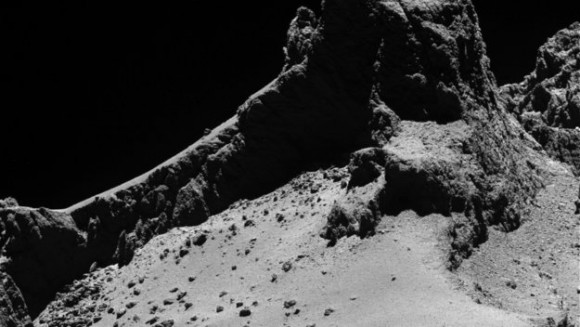
The comet’s vital statistics. The familiar shape of the dual-lobed comet has now had many of its vital statistics measured: the small lobe measures 2.6 x 2.3 x 1.8 km and the large lobe 4.1 x 3.3 x 1.8 km. The total volume of the comet is 21.4 km3 and the Radio Science Instrument has measured its mass to be 10 billion tons, yielding a density of 470 kg/m3.
By assuming an overall composition dominated by water ice and dust with a density of 1,500-2,000 kg/m3, the Rosetta scientists show that the comet has a very high porosity of 70-80%, with the interior structure likely comprising weakly bonded ice-dust clumps with small void spaces between them.
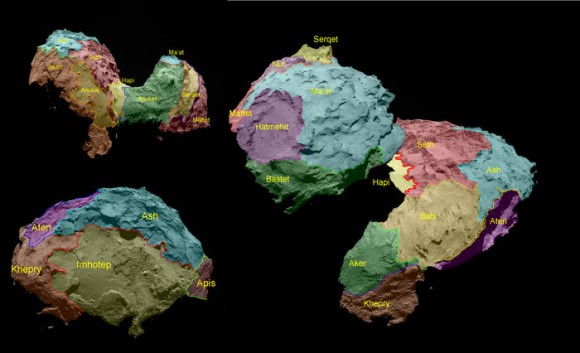
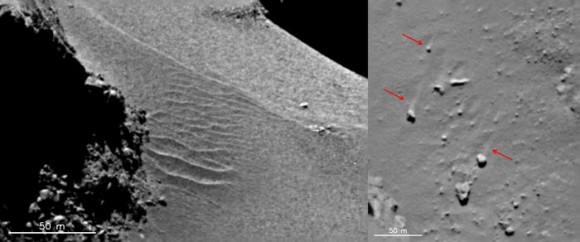
Some 70% of surface imaged so far. The OSIRIS scientific camera has imaged some 70% of the surface to date: the remaining unseen area lies in the southern hemisphere that has not yet been fully illuminated since Rosetta’s arrival.
The scientists have so far identified 19 regions separated by distinct boundaries and, following the ancient Egyptian theme of the Rosetta mission, these regions are named for Egyptian deities, and are grouped according to the type of terrain dominant within.
Five basic — but diverse — categories of terrain type have been determined: dust-covered; brittle materials with pits and circular structures; large-scale depressions; smooth terrains; and exposed more consolidated (‘rock-like’) surfaces.
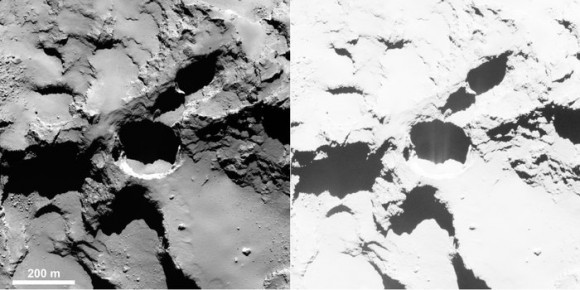
Dust and jets. Much of the northern hemisphere is covered in dust. As the comet is heated, ice turns directly into gas that escapes to form the atmosphere or coma. Dust is dragged along with the gas at slower speeds, and particles that are not traveling fast enough to overcome the weak gravity fall back to the surface instead.
Some sources of discrete jets of activity have also been identified. While a significant proportion of activity emanates from the smooth neck region, jets have also been spotted rising from pits.
The gases that escape from the surface have also been seen to play an important role in transporting dust across the surface, producing dune-like ripples, and boulders with wind-tails — the boulders act as natural obstacles to the direction of the gas flow, creating streaks of material downwind of them.
The dusty covering of the comet may be several meters thick in places and measurements of the surface and subsurface temperature by the Microwave Instrument on the Rosetta Orbiter, or MIRO, suggest that the dust plays a key role in insulating the comet interior, helping to protect the ices thought to exist below the surface.
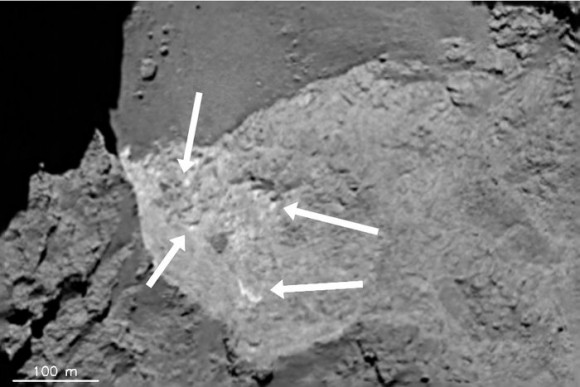
Ice on the surface. Small patches of ice may also be present on the surface. At scales of 15-25 meters (50-65 feet), Rosetta instruments find the surface to be compositionally very homogenous and dominated by dust and carbon-rich molecules, but largely devoid of ice. But smaller, bright areas seen in images are likely to be ice-rich. Typically, they are associated with exposed surfaces or debris piles where collapse of weaker material has occurred, uncovering fresher material.
Some very steep regions of the exposed cliff faces are textured on scales of roughly 3 meters (10 feet) with features that have been nicknamed goose bumps. Their origin is yet to be explained, but their characteristic size may yield clues as to the processes at work when the comet formed.

The comet’s mysterious double-lobed shape. And on the very largest scale, the origin of the comet’s overall double-lobed shape remains a mystery. The two parts seem very similar compositionally, potentially favoring the erosion of a larger, single body. But the current data cannot yet rule out the alternative scenario: two separate comets formed in the same part of the solar system and then merged together at a later date.
This key question will be studied further over the coming year as Rosetta accompanies the comet around the sun.
Watching, as the comet draws near the sun. The comet and spacecraft’s closest approach to the sun occurs on August 13, 2015 at a distance of 186 million kilometers (116 million miles), between the orbits of Earth and Mars. As the comet continues to move closer to the sun, an important focus for Rosetta’s instruments is to monitor the development of the comet’s activity, in terms of the amount and composition of gas and dust emitted by the nucleus to form the coma.
Images from the scientific and navigation cameras have shown an increase in the amount of dust flowing away from the comet over the past six months, and MIRO showed a general rise in the comet’s global water vapor production rate, from 0.3 liters per second in early June 2014 to 1.2 liters per second by late August. MIRO also found that a substantial portion of the water seen during this phase originated from the comet’s neck.
Water is accompanied by other outgassing species, including carbon monoxide and carbon dioxide. One instrument on Rosetta has found large fluctuations in the composition of the coma, representing daily and perhaps seasonal variations in the major outgassing species. Water is typically the dominant outgassing molecule, but not always.
By combining measurements by several instruments taken between July and September, the Rosetta scientists have made a first estimate of the comet’s dust-to-gas ratio, with around four times as much mass in dust being emitted than in gas, averaged over the sunlit nucleus surface.
However, this value is expected to change once the comet warms up further and ice grains — rather than pure dust grains — are ejected from the surface.
Scientists have also been tracking the movement of dust grains around the comet, and, together with images from the mission’s OSIRIS camera, two distinct populations of dust grains have been identified. One set is outflowing and is detected close to the spacecraft, while the other family is orbiting the comet no closer than 130 kilometers (80 miles) from the spacecraft.
It’s thought that the more distant grains are left over from the comet’s last closest approach to the sun. As the comet moved away from the sun, the gas flow from the comet decreased and was no longer able to perturb the orbits of these distant grains around the comet. But as the gas production rate increases again over the coming months, it is expected that these leftover grains will dissipate. However, Rosetta will only be able to confirm this when it is further away from the comet again. The spacecraft is currently in a 30-km (20-mile) orbit.
Breaking news: Rosetta watches comet shed its dusty coat
As the gas-dust coma continues to grow, interactions with charged particles of the solar wind and with the sun’s ultraviolet light will lead to the development of the comet’s ionosphere and, eventually, its magnetosphere. Matt Taylor, ESA’s Rosetta project scientist, said:
Rosetta is essentially living with the comet as it moves towards the sun along its orbit, learning how its behavior changes on a daily basis and, over longer timescales, how its activity increases, how its surface may evolve, and how it interacts with the solar wind.
We have already learned a lot in the few months we have been alongside the comet, but as more and more data are collected and analyzed from this close study of the comet we hope to answer many key questions about its origin and evolution.
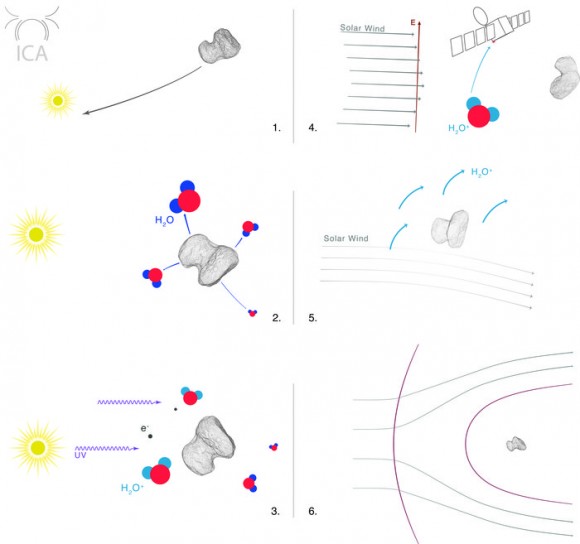
Bottom line: Scientists publish a slew of science results from the Rosetta comet mission. Among the most fascinating … a crack in the comet’s neck! Plus dust and jets on the comet, ice on its surface, its mysterious double-lobed shape, and what will happen as it draws near the sun.











